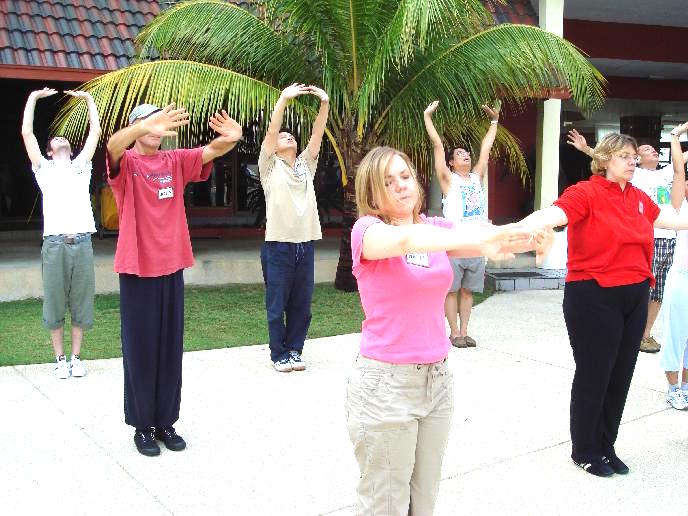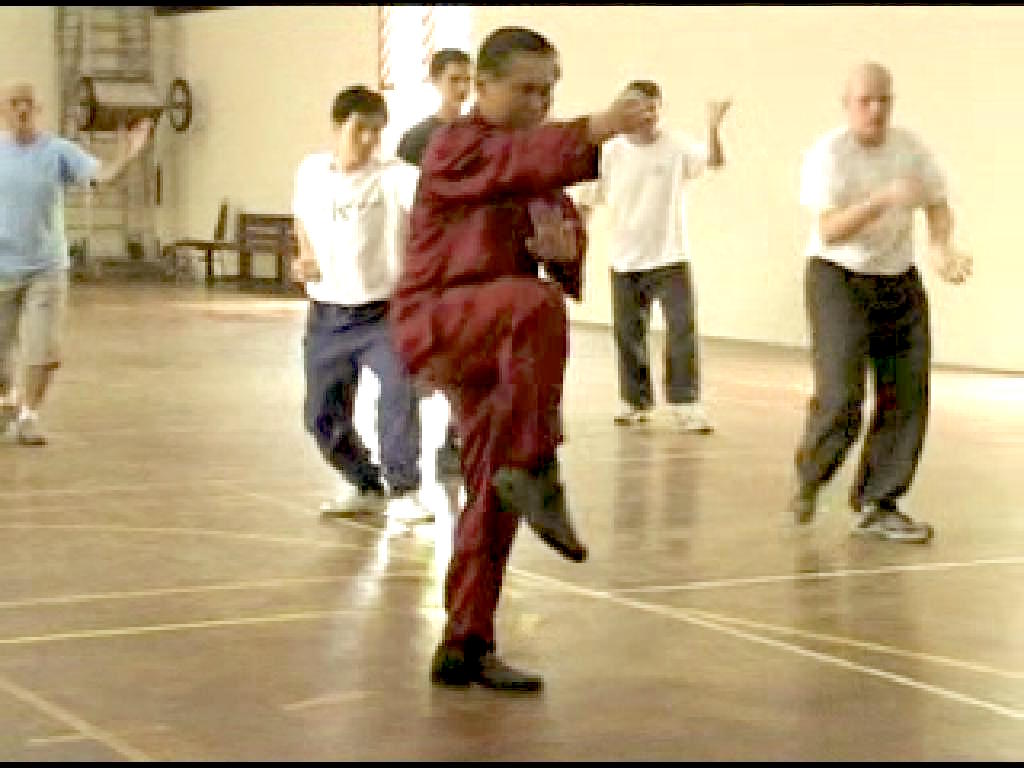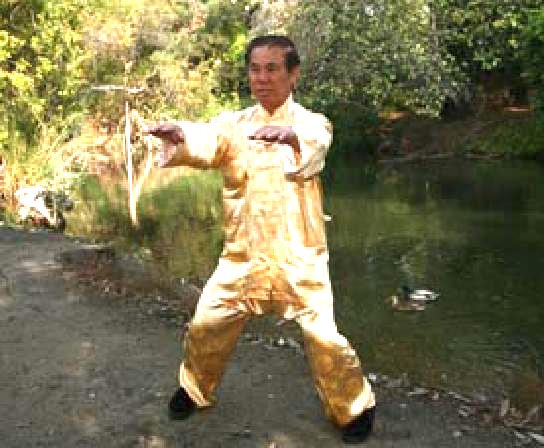SELECTION OF QUESTIONS AND ANSWERS
JUNE 2010 PART 1

We use kungfu patterns, not kick-boxing, for combat
Question 1
As a supporter of Wahnam, I'd like to share a concern regarding the Forum. This may be relevant to the resignations of prominent members in the past few months. In brief, the Forum is a powerful network and a way to ensure the spirit of Wahnam presents in a positive light. I believe this power has been eroded and hence share my thoughts.
— Erik, South Africa
Answer
I have followed the relevant discussion in our Discussion Forum, which is also our Virtual Kwoon. My students in the Virtual Kwoon were polite to you, which I am proud of, but I shall be blunt.You are not even a student of Shaolin Wahnam, and know little or nothing about our school or about the background in the discussion. Yet, using a pseudonym, Hellsviking, which arouses suspicion rather than respect, you suddenly came into the discussion and started giving advice as if you were an expert or authority.
Your concern is grossly unfounded. The two students in question who resigned from our school were not prominent members as you wrongly believed. One was actually ungrateful. By his own admission, he literally owed his life to our training, yet citing our fee as too high he resigned. The other resigned to follow his sifu, who had resigned earlier because he wanted to teach our arts differently from what we are doing.
While we value every one of our students, we do not want anyone unhappy with our school to remain. And we walk our talk. We prefer those who are unhappy to leave. Some have, including some prominent members, and we sincerely wish them well.
More than 30,000 people have learnt from us. While many of them may not be practicing our arts actively, less than 20 people have explicitly tendered their resignation. If we take a very conservative estimate that only 10% of those who have learnt from us are actively practicing, we have at least 3000 active members, from whom 20 have resigned. This works out to a resignation rate of less than 1 percent. So why are you so concerned when you are not even a member of our school, and especially when our instructors have patiently explained to you that we prefer undeserving students to leave.
Question 2
Some senior Forum members appear to be extremely defensive in response to certain questions e.g. regarding the efficacy of Wahnam methods in relation to other styles, financial issues and the question of respect. I believe Wahnam has little to be defensive about with respect to the core value of its teachings, financial and otherwise; however, some "scholar warriors" have been ineffective in reflecting this value and have, I believe, diminished its light and potential contribution to the community.
Answer
Are you a grandmaster or an authority in management? If you were, you should know that it is none of your business to interfere into how we run our school. If you are not even an instructor or a forum administrator, you should not be so arrogant to tell successful instructors and forum administrators how to handle their students or forum. In colloquial terms, don't teach your grandmother how to suck eggs.
This does not mean we do not listen to others. When our students, instructors or other people give their opinions, we listen. If their opinions are commendable and appropriate, we act on them. But we do not want someone like you who stubbornly tell us what to do, despite having been politely told to mind your own business.
We need not be defensive regarding our training methods, fees and questions of respect. While we genuinely respect other schools and would not argue with them what they think is best for their students, we are authoritative in regards to the affairs of our school. We speak from the position of strength, we do not entertain bargaining.
If a student does not agree with our training methods, says our fees are high, or does not respect his seniors, we ask him to leave. Similarly, if an outsider comes into our Virtual Kwoon and tells us that internal force is bullshit, we should make our teaching available free for any Tom, Dick and Harry, or students can treat their teachers like buddies, we throw him out.

We beleive in chi, or vital energy
Question 3
Time and again, such requests or queries arise. Time and again, the individuals are attacked personally, undermined and -- if they persist -- banned from the Forum.
Answer
This shows how tolerant we have been. If you check the records of our Virtual Kwoon, you will find that time and again those who are banned were the ones who came into our Virtual Kwoon persistently telling us that our philosophy or methods were wrong, and they were also rude to our instructors.
They told us, for example, that kungfu techniques could not be used for fighting, that we could not handle a shoot, that bouncing about and punching like Boxers were Taijiquan, and that chi was unreal. We did not attack them personally. We were courteous to them even when we disagreed with their philosophy and practice. We also had no quarrel with what they chose to believe and practice, but we did not want them to come to our Virtual Kwoon and tell our students that what we taught was rubbish.
We also did not ban them because of their different opinions. They were banned because eventually they became rude and abusive.
Question 4
Is it possible that the individual inputs may be seen as representing something arising in the community that wishes to express itself, a spirit that has an important message but lacks the means for direct expression?
Answer
No, the inputs from these individuals who are banned from our Virtual Kwoon do not represent anything from our school that lacks access for direction.
Our students and instructors have a lot of opportunities to express their different views -- like in regular classes, in regional and intensive courses, in our Virtual Kwoon, via e-mails, over meals, and during excursions. If these views are appropriate and beneficial, we accept and implement them. Singing, poetry recitation, supplementary courses like Tan Tui and Praying Mantis, the art of negotiation, the Warrior Project and Scholar Project are some examples.
On the other hand, the inputs from those banned individuals were concepts contrary to our philosophy and practice. Their concepts, if left unchecked, could corrupt our students, or cause doubt in them. Some examples are their saying that kungfu cannot be used for fighting, chi is non-existent and that our arts should be easily available to all.
I would like to remind you and others like you that we have always mentioned that we teach only to deserving students, not just anyone who merely expresses his wish to learn from us. This is different from the principle that equality is (or is not) a virtue.
Of course we would like everyone in the world to be healthy and wholesomely rich. This is an ideal. But in practice, this is not possible. Similarly we would like the wonderful benefits of our arts to be enjoyed by all people, but in practice this may not be possible. Our arts are elite, which means not anyone can practice it -- just as to be a doctor or a top manager is elite, not anyone can be a doctor or a top manager. Nevertheless we have done our part in making these elite arts accessable to more people irrespective of race, culture and religion.

We charge high fees. These students, for example, pay 1500 euros for a five-day Shaolin Kungfu course
Question 5
If this is so, the individuals are not merely speaking for themselves; rather they speak for a broader, shadow side of the Wahnam community. Because such shadow issues are continually denied by some seniors, they return again and again with different actors but the same voice. They are symptoms; they are not the problem.
Answer
This is not so. As I have said, I shall be blunt.
You and those banned individuals do not speak for anyone in our school. There is no one in our school like you or them because we would not accept such people into our school in the first place. If they accidentally got into our school, they would eventually leave, or we would ask them to leave.
Ours is a school teaching traditional internal martial arts, which include using traditional kungfu forms for combat, cultivating chi and developing internal force. We also say that we teach only deserving students and our students must respect their teachers and seniors.
Now come some anonymous critics who think too highly of themselves. They tell our students that kungfu forms cannot be used for combat, that chi is unreal, and that internal force is bullshit. Or they tell our students that we should not charge high fees, that we should make our arts available to all.
It is a big credit to our instructors and senior members that they take time patiently explaining to these anonymous critics that what they (the anonymous critics) believe and practice is their own business which we are not interested in, but our direct experiences confirm for us that kungfu forms can be used for combat, that chi and internal force are real. We also explain that we are perfectly happy with the fees. Our instructors and senior members could have just asked these anonymous critics to shut up and leave our school.
Question 6
I am interested in learning Shaolin Kung Fu. My main goal is to train in China, but the big question is where do I start?
— Eric, Germany
Answer
First of all you need to know that what is popularly taught in China today is modern wushu and not traditional Shaolin Kungfu.
Except for Taijiquan which is also a part of modern wushu, the forms taught in modern wushu are similar to the forms taught in traditional Shaolin Kungfu. In other words, by looking at their outward performance, it may not be easy for most people to tell the difference between modern wushu and traditional Shaolin Kungfu.
The difference lies in their training method and application. Generally modern wushu training is external like gymnastics, and is mainly used for demonstration. Much of genuine traditional Shaolin Kungfu training is internal involving energy and mind, and is meant for combat efficiency, good health and spiritual cultivation.
There are many schools in China teaching excellent modern wushu. You can find them through the internet.
Schools teaching traditional Shaolin Kungfu are rare in China today, but there are many outside China. You can also find them through the internet. However, not many of these schools pay much attention to internal training and spiritual cultivation.

Grandmaster Wong demonstrating "Lifting Water"
Question 7
I have a question for Sifu Wong to see how advanced is his knowledge about Chi Kung. I would like to ask if he knows how to fuse yang and yin energy in dan tian.
— Sebastian, Spain
Answer
Firstly, I shall answer your question directly. Yes, I know how to fuse yin and yang energy in the dan tian. Many of our Shaolin Wahnam instructors and students also know how to do that.
Now, I would like to elaborate on the answer, which may be very different from what you want.
Different masters and different people may use the terms "yin" and "yang" differently. We in Shaolin Wahnam use the terms in the same way as Chinese philosophers and masters in the past used them, though their meaning and significance are actually little understood by many people, including many Chinese, today.
Yin and yang are symbols referring to two opposite yet complementary aspects of the universe. They are not absolute references for any particular things or concepts. Hence, yin and yang may have different meanings in different context.
In other words, you cannot point to a certain thing like a table, or a concept like wisdom, as yin or yang. For example, you cannot say the table is yin, or wisdom is yang.
The table or wisdom can be yin or yang depending on its relationship with another thing or concept. Usually the other thing or concept with which to compare with the table or wisdom is not mentioned, but is understood. If the other thing or concept is not presence, then the table or wisdom is neither yin nor yang.
Let us take an easier example. We usually refer to a man as yang. This is because we compare him with a woman. Although the woman is not mentioned, it is understood. Suppose there were no women (which would make the world rather uninteresting), then men could neither be yin nor yang.
Now, suppose we are not comparing this man with a woman, but comparing him with a bigger-sized man. Then this man, whom we regarded as yang when compared to a woman, is now yin when compared to a bigger-sized man.
Hence, by itself a table or wisdom is neither yin nor yang. But if we compare a table with a chair, the table is yang. If we compare the table with a person at the table, the table is yin. When we compare wisdom with ignorance, wisdom is yang. But if we compare wisdom with courage, wisdom is yin.
So, whether the energy in the dan tian is yin or yang depends on its relationship with other factors. If we compare the energy that is at the upper part of the dan tian with the energy at the lower part, the former is yang and the latter yin. If we compare energy that brings nourishment with energy that provides protection, irrespective of where it is found in the dan tian, nourishing energy is yin and protective energy is yang.
I can circulate my energy in my dan tian in a small universal flow, which means yin energy at the lower part of the dan tian can be fused with yang energy at the upper part. I can also use the energy that brings nourishment to my cells to protect my body, and vice versa, meaning I can fuse the yin energy with the yang energy.
Question 8
What do you think it needs to make a real hard strike with the hand?
— Eugene, Hungary
Answer
You can make a real hard strike using external strengh or internal force.
If you prefer external strength, a good method is to practice hitting a sand-bag a few hundred times every day for a year. A strike by your hand can cause serious damage to ordinary people.
If you prefer internal force, there are many methods but you need to learn from a master. One good method is to practice "Lifting Water". If you practice "Lifting Water" for about 15 minutes every day for a year, a hard strike by you can also cause severe damage to ordinary people.
When you are more advanced, your strike need not even be hard. You may give an opponent a seemingly gentle tap, yet the damage can be more serious than a hard strike.
When you have practiced "Lifting Water" or any internal force training daily for a year, the internal force can be used for many benefits besides making a hard, or a soft, strike on opponents. It will, for example, strengthen your internal organs, give you more stamina, and enable you to enjoy your work and play. The external strength derive from hitting a sand-bag is quite limited to only striking opponents or breaking bricks for demonstration.
LINKS
Selected Reading
- I Could Never Pay You Enoguth for this Gift
- The Joy of Being with Others
- The Small Universe and Shaolin Cosmos Chi Kung
- Sparring and Internal Force
- The Three Secrets
